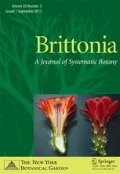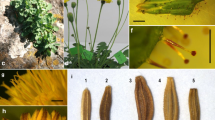Abstract
Characeae is a family of freshwater green algal macrophytes found on every continent except Antarctica. Although some species are thought to be cosmopolitan, others appear to be restricted to relatively small geographic areas. Chara brittonii is a North American endemic previously reported from eight scattered populations in Indiana, Michigan, New Jersey, and Ohio. Given that few extant populations were known, basic questions about its distribution, habitat preference, morphology, and phylogenetic placement remained unanswered. We have surveyed every reported locality for C. brittonii except the New Jersey locality, because the collection details are vague, and also surveyed numerous additional waterbodies in Indiana, Michigan, and Wisconsin. We have found extant populations in nine localities in three states. These include one newly reported site in Indiana and five newly reported sites in Wisconsin, the first known populations in that state. Chara brittonii seems to have been extirpated from several historical sites in recent decades. We expanded both the range and the number of known extant populations for C. brittonii and hypothesize that C. brittonii may be more widespread in the Midwest than previously thought. Factors contributing to the actual and apparent rarity of this species are discussed including its preferred habitat and small size. We observed that the number of antheridial scute cells of C. brittonii varied from 4–8 with both triangular and elongate scutes produced on the same thallus, an unusual condition for the family. Phylogenetic analyses using three plastid-encoded markers placed C. brittonii among a paraphyletic grade of C. foliolosa sensu lato strains in the monophyletic subsection Willdenowia. We propose that C. foliolosa, as currently recognized, represents a species complex of several phylogenetically distinct lineages, and conclude that C. brittonii is a structurally and phylogenetically distinct species worthy of conservation.



Similar content being viewed by others
Literature cited
Alix, M. S. & R. W. Scribailo. 2011. Charophyceae, Charales, Characeae, Chara drouetii R. D. Wood, 1965: First record for the state of Quintana Roo, Mexico. Check List 7: 21–24.
Alix, M. S., R. W. Scribailo & C. W. Weliczko. 2017. Nitellopsis obtusa (Desv.) J. Groves, 1919 (Charophyta: Characeae): new records from southern Michigan, USA with notes on environmental parameters known to influence its distribution. BioInvasions Records 6: 311–319.
Allen, T. F. 1880–1893. Characeae Americanae Exsiccatae, Fasc. I: 1–10, II: 11–20 (1880); III: 21–30, IV: 31–40a (1888); V: 41–46 (1893).
–––––. 1888. Characeae of America. John C. Rankin, Jr., New York.
Bednarz, R., H. Wandell, P. Steen, P. W. Dimond, J. Latimore & W. Dimond. 2015. Cooperative Lakes Monitoring Program Manual. Michigan Department of Water Quality, Water Bureau MI/DEQ/WRD-15/004, Lansing, MI.
Blindow, I., A. Hargeby & G. Andersson. 2002. Seasonal changes of mechanisms maintaining clear water in a shallow lake with abundant Chara vegetation. Aquatic Botany 72: 315–334.
Brainard, A. S. & K. L. Schulz. 2016. Impacts of the cryptic macroalgal invader, Nitellopsis obtusa, on macrophyte communities. Freshwater Science 36: 55–62.
Braun, A., & C. F. O. Nordstedt. 1882. Fragmente einer Monographie der Characeen. Nach den hinterlassenen Manuscripten A. Braun’s. ‘Abhandlungen Königlichen Akademie der Wissenschaften zu Berlin 1882’
Casanova, M. T., A. García & J. L. Porter. 2003. Charophyte rediscoveries in Australia: what and why? Acta Micropalaeontologica Sinica 20: 129–138.
Collins, F. S., I. Holden & W. A. Setchell. 1895–1919. Phycotheca Boreali-Americana 1–46, A-E: 1–2300, I-CXXV.
Daily, F. K. 1953. The Characeae of Indiana. Butler University Botanical Studies 11: 5–49.
–––––. 1958. Some observation on the occurrence and distribution of Characeae in Indiana. Proceedings of the Indiana Academy of Science 68: 95–107.
Escobar, L. E., H. Qiao, N. D. B. Phelps, C. K. Wagner & D. J. Larkin. 2016. Realized niche shift associated with the Eurasian charophyte Nitellopsis obtusa becoming invasive in North America. Scientific Reports 6: 1–15.
Griffin, D. G., III, & V. W. Proctor. 1964. A population study of Chara zeylanica in Texas, Oklahoma, and New Mexico. American Journal of Botany 51: 120–124.
Groves, J. 1931. On the antheridium of Chara zeylanica Willd. Journal of Botany, British and Foreign 69: 97–98.
Guindon, S., J. F. Dufayard, V. Lefort, M. Anisimova, W. Hordik & O. Gascuel. 2010. New algorithms and methods to estimate maximum-likelihood phylogenies: assessing the performance of PhyML 3.0. Systematic Biology 59: 307–321.
Hall, J. D. & K. G. Karol. 2016. Inventory of freshwater algae (excluding diatoms) of Harriman State Park (Rockland and Orange Counties, New York). Brittonia 68: 148–169.
–––––, K. Fučiková, C. Lo, L. A. Lewis & K. G. Karol. 2010. An assessment of proposed DNA barcodes in freshwater green algae. Cryptogamie, Algologie 31: 529–555.
Hauxwell, J., S. Knight, K. I. Wagner, A. Mikulyuk, M. E. Nault, M. Porzky & S. Chase. 2010. Recommended baseline monitoring of aquatic plants in Wisconsin: sampling design, field and laboratory procedures, data entry and analysis, and applications. WI-DNR Bureau of Science Services: PUB-SS-1068.
Hiebert, R. D., D. A. Wilcox & N. B. Pavlovic. 1986. Vegetation patterns in and among pannes (calcareous intradunal pools) at the Indiana Dunes National Lakeshore, Indiana. American Midland Naturalist 116: 276–281.
Huelsenbeck, J. P. & F. Ronquist. 2000. MRBAYES: Bayesian inference of phylogeny. Distributed by the authors.
Hutchinson, G. E. 1975. A treatise on limnology. Vol. 3. John Wiley & Sons, New York, London, Sydney.
INDNR. 2014. Tier II aquatic vegetation survey protocol. Indiana Department of Natural Resources, Division of Fish and Wildlife, Indianapolis, Indiana.
–––––. 2015. Emergent vegetation survey protocol. Indiana Department of Natural Resources, Division of Fish and Wildlife, Indianapolis, Indiana.
Jeppesen, E., M. A. Søndergaard, M. O. Søndergaard & K. Christoffersen. 1998. The structuring role of submerged macrophytes in lakes. Springer, New York.
Karol, K. G. & R. S. Sleith. 2017. Discovery of the oldest record of Nitellopsis obtusa (Charophyceae, Charophyta) in North America. Journal of Phycology. https://doi.org/10.1111/jpy.12557
–––––, P. M. Skawinski, R. M. McCourt, M. E. Nault, R. Evans, M. E. Barton, M. S. Berg, D. J. Perleberg & J. D. Hall. 2017. First discovery of the charophycean green alga Lychnothamnus barbatus (Charophyceae) extant in the New World. American Journal of Botany 104: 1108–1116.
Lanfear, R., B. Calcott, S. Y. W. Ho & S. Guindon. 2012. PartitionFinder: combined selection of partitioning schemes and substitution models for phylogenetic analyses. Molecular Biology and Evolution 29: 1695–1701.
–––––, P. B. Frandsen, A. M. Wright, T. Senfeld & B. Calcott. 2017. PartitionFinder 2: new methods for selecting partitioned models of evolution for molecular and morphological phylogenetic analysis. Molecular Biology and Evolution https://doi.org/10.1093/molbev/msw260.
Mann, H., V. W. Proctor & A. S. Taylor. 1999. Toward a biogeography of North American charophytes. Australian Journal of Botany 47: 445–458.
Meiers, S. T., V. W. Proctor & R. L. Chapman. 1999. Phylogeny and biogeography of Chara (Charophyta) inferred from 18S rDNA sequences. Australian Journal of Botany 47: 347–360.
Mikulyuk, A., J. Hauxwell, P. Rasmussen, S. Knight, K. I. Wagner, M. E. Nault & D. Ridgley. 2010. Testing methodology for assessing plant communities in temperate inland lakes. Lake and Reservoir Management 26: 54–62.
Miller, M. A., W. Pfieffer & T. Schwartz. 2010. Creating the CIPRES Science Gateway for inference of large phylogenetic trees. Proceedings of the Gateway Computing Environments Workshop (GCE), New Orleans, LA: 1–8.
Parker, B. C., G. J. Schumacher & L. A. Whitford. 1984. Some rarely reported algae of the Appalachian Mountains: why so rare? Virginia Journal of Science 35: 197–215.
Pérez, W., J. D. Hall, R. M. McCourt & K. G. Karol. 2014. Phylogeny of North American Tolypella (Charophyceae, Charophyta) based on plastid DNA sequences with a description of Tolypella ramosissima sp. nov. Journal of Phycology 50: 776–789.
–––––, M. T. Casanova, J. D. Hall, R. M. McCourt & K. G. Karol. 2016. Phylogenetic congruence of ribosomal operon and plastid gene sequences for the Characeae with an emphasis on Tolypella (Characeae, Charophyceae). Phycologia 56: 230–237.
Proctor, V. W. 1962. Viability of Chara oospores taken from migratory waterfowl. Ecology 43: 528–529.
–––––. 1999. Charophytivory, playas y papalotes, a local paradigm of global relevance. Australian Journal of Botany 47: 399–406.
––––– & F. H. Wiman. 1971. An experimental approach to the systematics of the monoecious-conjoined members of the genus Chara, series Gymnobasalia. American Journal of Botany 58: 885–893.
–––––, D. G. Griffin III & A. T. Hotchkiss. 1971. A synopsis of the genus Chara, series Gymnobasalia (subsection Willdenowia RDW). American Journal of Botany 58: 894–901.
Robinson, C. B. 1906. The Chareae of North America. Bulletin of the New York Botanical Garden 4: 244–308.
Sawa, T. 1973. Two new species of Tolypella (Characeae) from North America. Journal of Phycology 9: 472–482.
Scribailo, R. W. & M. S. Alix. 2010. A checklist of North American Characeae. Charophytes 2: 38–52.
Sleith, R. S., A. J. Havens, R. A. Stewart & K. G. Karol. 2015. Distribution of Nitellopsis obtusa (Characeae) in New York, U.S.A. Brittonia 67: 166–172.
Stamatakis, A., M. Ott & T. Ludwig. 2005. RAxML-OMP: an efficient program for phylogenetic inference on SMPs. Proceedings of the 8th International Conference on Parallel Computing Technologies (PaCT2005), Lecture Notes in Computer Science, 3506: 288–302.
–––––, P. Hoover & J. Rougemont. 2008. A fast bootstrapping algorithm for the RAxML web-servers. Systematic Biology 57: 758–771.
Swofford, D. L. 2003. PAUP*: Phylogenetic analysis using parsimony (*and other methods). Version 4., Sinauer Associates, Sutherland, Massachusetts.
Thiers, B. 2017. Index Herbariorum: A global directory of public herbaria and associated staff. New York Botanical Garden's Virtual Herbarium. http://sweetgum.nybg.org/science/ih/
Wood, R. D. 1962. New combinations and taxa in the revision of Characeae. Taxon 11: 7–25.
––––– & K. Imahori. 1965. A Revision of the Characeae. Verlag von J. Cramer, Weinheim.
Acknowledgments
We thank BUT, CACS, ILL, NY, PUL, and UWSP for providing specimens for this study. We especially acknowledge the University of Wisconsin Herbarium (WIS) for generously providing specimens on loan and allowing us to review their recent collections. We are particularly grateful for the assistance in field collections and sample preparations provided by Ryan Scribailo. We also thank two anonymous reviewers for critically evaluating and improving the manuscript. This material is based upon work supported by the National Science Foundation under grant numbers DEB-1020660 and DEB-1036466 and by the Hanes Trust under grant number 205891.
Author information
Authors and Affiliations
Corresponding author
Electronic supplementary material
Suppl. Material 1
Phylogeny of Characeae based on a Maximum Likelihood (RAxML) analysis of three plastid-encoded genes (atpB, psbC, rbcL). Numbers above the branches represent, respectively, bootstrap support from Maximum Parsimony and RAxML analyses and posterior probabilities from Bayesian Inference. An asterisk represents a bootstrap value of 100 or a posterior probability of 1.0. A dash represents a bootstrap value of 50 or less and a posterior probability of 0.5 or less. Numbers in brackets are barcodes for herbarium specimens. NY = William and Lynda Steere Herbarium, The New York Botanical Garden; US = National Museum of Natural History Herbarium, Smithsonian Institution. The genera Lamprothamnium, Lychnothamnus, Nitella, Nitellopsis, and Tolypella were found to be monophyletic. However, the subfamily Nitelleae was paraphyletic with Nitella sister to the Chareae. (GIF 926 kb)
Rights and permissions
About this article
Cite this article
Karol, K.G., Alix, M.S., Scribailo, R.W. et al. New records of the rare North American endemic Chara brittonii (Characeae), with comments on its distribution. Brittonia 70, 277–288 (2018). https://doi.org/10.1007/s12228-018-9527-3
Published:
Issue Date:
DOI: https://doi.org/10.1007/s12228-018-9527-3




